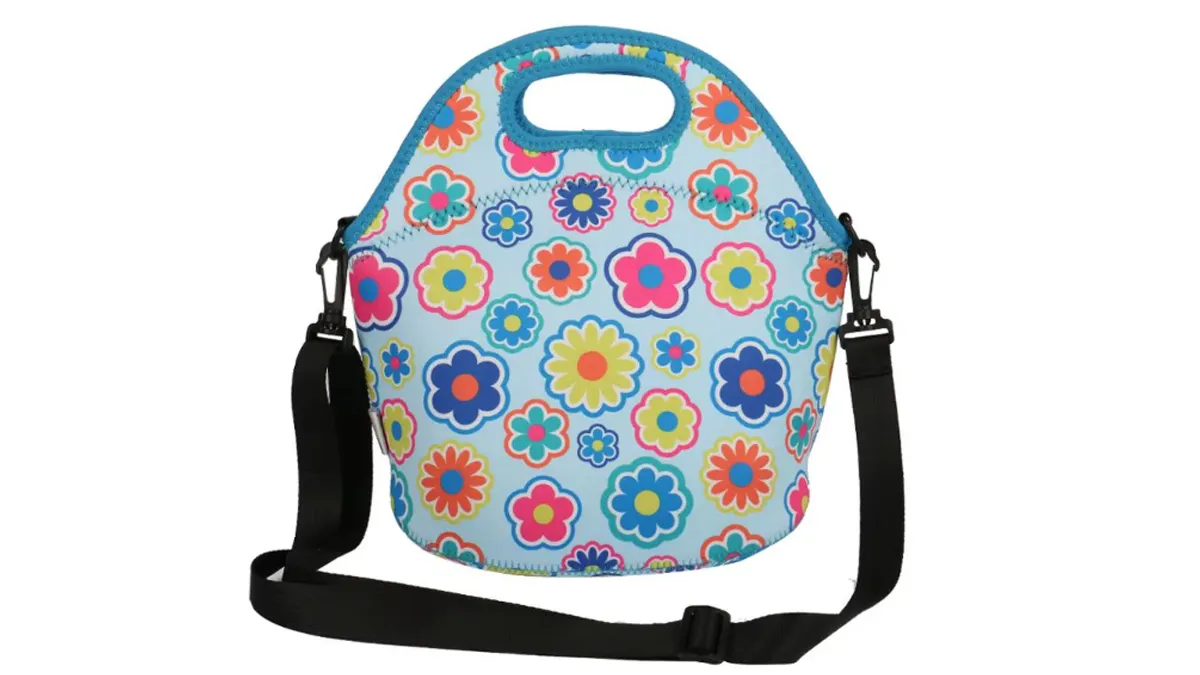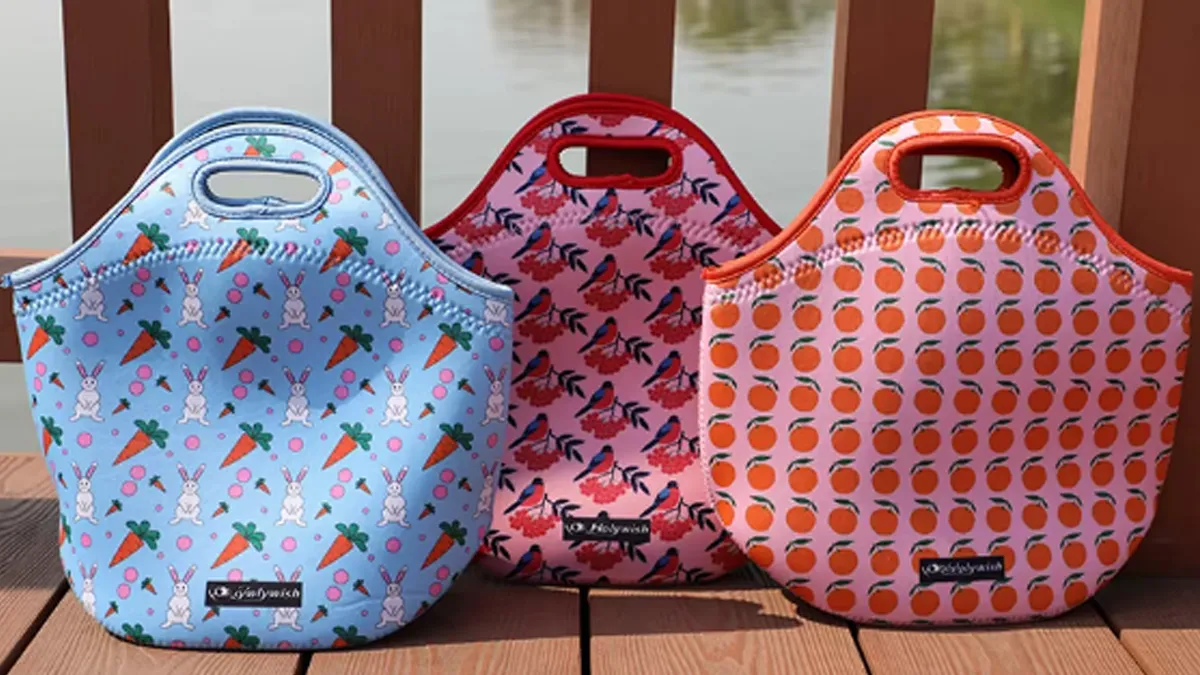Neoprene is one of the most effective materials used in insulated lunch bags because it combines thermal protection, water resistance, and durability. Unlike thin foil or basic fabric bags, Neoprene Lunch Bags keeps food warm or cold for several hours while preventing condensation and spills. Its flexible structure makes lunch bags lightweight, reusable, and comfortable to carry, which is why many schools, offices, and outdoor users prefer neoprene lunch bags over other options.

What Is Neoprene?
Definition and Properties of Neoprene
Neoprene is a synthetic rubber material first developed in the 1930s. It is widely known for its flexibility, durability, and resistance to water. If you think about wetsuits, laptop sleeves, or sports braces, they are often made from neoprene. These same qualities make neoprene a practical choice for lunch bags.
Some key properties of neoprene:
- Lightweight but strong
- Naturally water-resistant
- Shock-absorbing and flexible
- Provides thermal insulation
Why Neoprene Is Used in Lunch Bags
Lunch bags made of neoprene are soft, easy to carry, and can keep food at a stable temperature for a reasonable amount of time. Since neoprene is water-resistant, it prevents spills and condensation from leaking out. The fabric is also easy to wipe clean, making it hygienic for daily use.
Is Neoprene a Good Insulator for Lunch Bags?
The short answer is yes—neoprene is an effective insulator for lunch bags. Let us break down why.
Thermal Insulation Ability
Neoprene has a closed-cell structure, meaning it traps tiny air pockets inside the material. These air pockets reduce heat transfer, allowing food and drinks to maintain their temperature. Whether you are packing hot soup or a chilled soda, a neoprene lunch bag slows down the temperature change for hours.
Water Resistance and Condensation Control
One big advantage of neoprene is its resistance to moisture. Cold drinks usually cause condensation on the outside of regular fabric bags. With neoprene, that moisture is contained. This means your desk, backpack, or car seat stays dry.
Durability and Everyday Use
Unlike thin insulated foil bags that tear easily, neoprene bags are strong and flexible. They can handle daily use, stretching to fit containers without losing shape. For families, office workers, and students, that durability makes neoprene a convenient long-term option.
Neoprene vs Other Lunch Bag Materials
Lunch bags are made from many different materials, from polyester and nylon to cotton and aluminum foil. Each has pros and cons. Here is a simple comparison:
| Material | Insulation | Water Resistance | Durability | Eco-Friendliness | Cost Range |
|---|---|---|---|---|---|
| Neoprene | Good (2–4 hrs) | Excellent | Very durable | Reusable, not biodegradable | Mid to high |
| Polyester | Moderate | Fair | Durable | Widely available, less eco-friendly | Low |
| Nylon | Moderate | Good | Durable | Less eco-friendly | Low |
| Foil Lining | Excellent (with padding) | Poor | Tears easily | Single-use mostly | Very low |
| Cotton | Poor (without lining) | Poor | Durable but absorbs moisture | Eco-friendly | Low to mid |
From this comparison, you can see that neoprene is not the cheapest material, but it provides a balance of insulation, water resistance, and durability. It is a great choice for people who want something practical and reusable.
How Long Does Neoprene Keep Food Warm or Cold?
Average Insulation Time
On average, neoprene lunch bags can keep food warm or cold for about 2–4 hours without additional ice packs or thermal containers. That is usually enough for school lunches, office breaks, or short outdoor activities.
Factors That Affect Insulation Performance
- Thickness of Neoprene: Thicker neoprene offers better insulation.
- Closure Type: Zippers provide tighter sealing compared to Velcro or open tops.
- External Conditions: Hot weather or leaving the bag in a car can shorten insulation time.
- Food Temperature: Starting with hot food in thermal containers or using ice packs for cold food improves results.
If you want maximum performance, combine neoprene with reusable ice packs or insulated containers.
Benefits of Neoprene Lunch Bags
Here are the main reasons people love neoprene lunch bags:
- Thermal Protection: Keeps meals fresh for several hours.
- Lightweight and Comfortable: Easy to carry daily.
- Water-Resistant: No worries about spills or condensation.
- Easy to Clean: Wipe down or even hand-wash.
- Customizable: Available in many colors, shapes, and prints.
- Reusable and Eco-Friendly: Helps reduce single-use plastic waste.
Limitations of Neoprene Lunch Bags
Of course, neoprene is not perfect. Here are some downsides:
- Shorter Insulation Compared to Foil-Lined Coolers: If you need food to stay cold all day, neoprene alone may not be enough.
- Higher Cost: Neoprene bags are generally more expensive than polyester or nylon.
- Not 100% Eco-Friendly: While reusable, neoprene itself is not biodegradable.
Still, for daily use, most people find neoprene strikes a good balance between performance and convenience.
Choosing the Right Neoprene Lunch Bag
Not all neoprene bags are the same. Here is how to choose the right one:
For Kids’ School Lunches
Lightweight, colorful, and easy-to-clean bags are ideal. Look for fun designs and easy-to-carry handles.
For Office Workers
Sleek, professional designs with zippers are best. A slightly larger size ensures space for containers and bottles.
For Outdoor Activities
Opt for thicker neoprene and consider additional insulation layers or ice pack compartments. Durability and water resistance are especially important here.
Custom Neoprene Lunch Bags for Your Brand
At our factory, we specialize in manufacturing custom neoprene lunch bags for brands, retailers, and promotional use. As a B2B manufacturer, we understand that businesses want products that are not only functional but also represent their brand well.
We offer:
- Custom sizes and thickness
- Wide range of colors and printing options (logos, patterns, branding)
- Different closure styles (zipper, Velcro, snap)
- Bulk order production with consistent quality
Whether you are a retailer wanting to expand your product line or a company planning corporate giveaways, we can deliver high-quality neoprene lunch bags tailored to your needs.
Conclusion
So, is neoprene a good insulator for lunch bags? Absolutely. It keeps food fresh for several hours, resists water and spills, and offers durability that cheap foil-lined bags cannot match. While it may not hold temperature as long as heavy-duty coolers, for daily use at school, work, or short trips, neoprene is one of the best lunch bag materials you can choose.
If you are looking for custom neoprene lunch bags that combine style, function, and quality, we are here to help. Contact us today to discuss your design ideas and bulk order requirements—we will make sure your brand stands out with bags that customers love to use.
FAQ
How long do neoprene lunch bags keep food warm or cold?
A standard neoprene lunch bag keeps food at the desired temperature for about 2–4 hours under normal conditions. Use thicker neoprene, insulated containers, or ice packs to extend that time.
Which insulates better, neoprene or foil lining?
Foil lining provides stronger short-term thermal reflection, especially for cold items. Neoprene offers better durability, water resistance, and everyday usability. Combine neoprene with an internal foil layer for the best balance.
Can I put a neoprene lunch bag in the microwave or oven?
Do not place a neoprene bag in the microwave or oven. Always transfer food to microwave-safe or oven-safe containers before heating.
How do I clean a neoprene lunch bag?
Hand wash with mild detergent or wipe with a damp cloth. Rinse and air dry flat. Avoid high-heat drying, bleach, and aggressive machine washing that can deform the material.
Will a neoprene bag have a rubber smell? How do I remove it?
New neoprene products may carry a faint rubber or chemical odor. Wash the bag with mild soap and air it in a ventilated area. Repeat if needed until the odor reduces.





